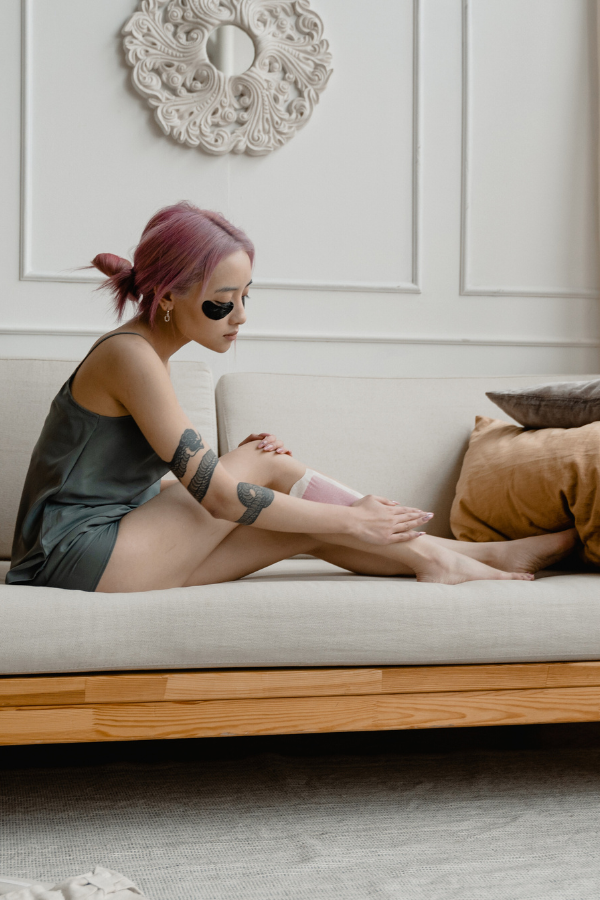

Beauty Myths Debunked: Does Waxing Cause Wrinkles?
Summary
Reflection Questions
Journal Prompt
Unfortunately, beauty myths and misconceptions abound, often perpetuated by well-intentioned advice, anecdotal tales, and popular beliefs. These myths can shape our beauty routines and influence the choices we make in pursuit of radiant skin. In this article, we turn our attention to one enduring beauty myth: the notion that waxing, a commonly practiced method of hair removal, contributes to the development of wrinkles. But is this true? Does waxing facial hair actually make your skin more prone to wrinkling? Are at-home waxing procedures more likely to produce these adverse effects than professional waxing? Read on to learn whether this beauty myth is just that or if there’s a bit of truth to the tall tale, and remember that wrinkled skin is beautiful, lived-in, expressive skin. This article is just about debunking myths; not about encouraging anyone to remove hair or change their skin in any way.
TLDR:


There is no direct scientific evidence linking waxing to the formation of wrinkles. The waxing process itself is not a direct cause of saggy skin.
Wrinkles primarily result from the natural aging process, genetics, exposure to UV radiation, and lifestyle factors.
Waxing is a hair removal method that targets hair follicles, not the collagen and elastin fibers responsible for skin elasticity and wrinkle formation.
Understanding Facial Waxing
Waxing is a widely practiced hair removal technique that involves applying a specially formulated hot wax to the skin in the target area. This wax is designed to adhere to the hairs in that region. Once applied, a cloth or paper waxing strip is pressed onto the wax-covered area and quickly removed against the direction of hair growth. This swift motion pulls the hairs out from the root, leaving the skin temporarily hair-free. Waxing is preferred by many for its longer-lasting results compared to shaving, as it takes more time for the hair to regrow from the root.
Common Areas of the Body Where Waxing is Performed
Waxing is commonly performed on various parts of the body, including but not limited to the legs, arms, underarms, face (including eyebrows and upper lip), bikini area, and back. The choice of waxing location largely depends on individual preferences and cultural norms. Different body areas may require specific types of wax or techniques to ensure safety and effectiveness.
Brief History of Waxing as a Hair Removal Method
Waxing as a hair removal method has a long history dating back to ancient civilizations, including ancient Egypt and Greece. Historically, natural substances like beeswax and sugaring were used for waxing. Over time, waxing techniques and formulas have evolved, incorporating modern materials and methods. Today, it remains a popular and widely available hair removal choice.
Fuel your creative fire & be a part of a supportive community that values how you love to live.
subscribe to our newsletter
Popularity and Prevalence of Waxing in Modern Beauty Routines
Waxing has gained enduring popularity in modern beauty routines due to its effectiveness and relatively longer-lasting results compared to alternatives like shaving. It is widely practiced in salons and spas, and there is also a market for at-home waxing kits. The convenience and smooth skin achieved through waxing have made it a common choice for individuals seeking temporary hair removal, contributing to its prevalence in contemporary beauty regimens.
The Science Behind Wrinkle Formation


Wrinkles are creases, lines, or folds that develop on the skin’s surface. They are primarily the result of changes in the skin’s structure and elasticity. Wrinkle formation begins with the breakdown of collagen and elastin, two essential proteins that provide skin with its strength and resilience.
As collagen and elastin production decreases over time, the skin becomes less able to bounce back from repetitive movements and stretching. This leads to the permanent indentations we recognize as wrinkles. Wrinkles can appear in various forms, including fine lines, deep furrows, and crow’s feet.
Factors Contributing to the Development of Wrinkles
Several factors contribute to the development of wrinkles. One of the primary factors is natural aging, as the body’s production of collagen and elastin naturally declines with age. Additionally, exposure to UV radiation from the sun plays a significant role in wrinkle formation. UV rays damage collagen and elastin fibers, accelerating the aging process.
Smoking is another notable contributor, as it narrows blood vessels in the skin and reduces blood flow, depriving the skin of essential nutrients. Furthermore, repetitive facial expressions, such as frowning or squinting, can cause dynamic wrinkles, which become more permanent over time.
The Role of Aging, Genetics, and External Factors in Wrinkle Formation
Aging is a fundamental factor in wrinkle formation. As individuals age, their skin undergoes intrinsic changes, including reduced collagen and elastin production, decreased skin cell turnover, and thinner skin. Genetics also play a role, as some individuals may be genetically predisposed to develop wrinkles earlier or more prominently than others.
External factors, such as sun exposure, smoking, pollution, and poor skincare practices, can exacerbate wrinkle development. UV radiation, in particular, is a major external factor, as it accelerates collagen breakdown and leads to premature aging. While genetics and aging are intrinsic factors that influence wrinkle formation, external factors are modifiable and can be managed to mitigate their impact on the skin.
Debunking the Waxing-Wrinkles Myth


The claim that waxing causes wrinkles has circulated within beauty discussions, prompting a closer examination. So, does repeated waxing of delicate facial skin cause wrinkles? It is important to clarify that there is no scientific basis for the assertion that waxing directly leads to the development of wrinkles. Wrinkles primarily result from factors related to skin aging, genetics, and external influences.
When using facial wax to remove hair, a technician targets the hair follicle. While some people with skin sensitivity might experience allergic reactions, redness, and irritation, applying wax and removing it swiftly does not directly impact the collagen and elastin fibers responsible for skin’s elasticity and wrinkle formation.
Expert Opinions and Dermatological Insights on Waxing and Skin Aging
Dermatologists and skincare experts have emphasized that face waxing, when performed correctly, should not contribute to premature aging or wrinkle formation. The consensus is that wrinkles are primarily influenced by intrinsic factors like aging and genetics, as well as extrinsic factors such as sun exposure and smoking. Dermatological insights underscore that tweezing, epilating, waxing, or laser hair removal do not interfere with the skin’s fundamental structural elements or the processes that lead to wrinkles.
Scientific Studies and Research Related to Waxing and Skin Health
Scientific studies on waxing have primarily focused on its efficacy as a hair removal method and potential side effects like skin irritation or ingrown hairs. These studies have not indicated a direct link between waxing and wrinkle development.
Instead, they emphasize proper waxing techniques and aftercare to minimize any adverse effects. While there is ongoing research in the field of dermatology, no compelling evidence has emerged to support the notion that waxing contributes to wrinkles.
Dispelling Misconceptions and Clarifying the Impact of Waxing on Skin
It is essential to dispel misconceptions surrounding waxing and wrinkles to provide accurate information to individuals making informed decisions about their beauty routines. Waxing, when conducted correctly and in line with recommended practices, is considered a safe and effective method of hair removal that does not induce wrinkle formation.
Understanding that wrinkles primarily result from intrinsic and extrinsic factors outside the realm of waxing allows individuals to make confident choices while pursuing their desired beauty regimens.
Tips for Safe and Effective Waxing


To ensure safe and effective waxing, it is essential to follow a few key tips. Firstly, individuals should conduct a patch test on a small, inconspicuous area of skin before waxing larger areas to check for any adverse reactions or allergies to the wax or other ingredients.
Additionally, cleanliness is paramount, so the skin should be thoroughly cleansed and dried before wax application. The wax should be heated to the recommended temperature, as overly hot wax can cause burns. When applying the wax, it is important to spread it evenly in the direction of hair growth and use proper technique when removing the wax strip.
Lastly, post-waxing care, including the application of soothing and moisturizing products, can help alleviate any potential discomfort.
Precautions to Minimize Potential Skin Irritation or Damage
To minimize the risk of skin irritation or damage during waxing, individuals should consider several precautions. It is advisable to avoid waxing over areas with open wounds, cuts, or sunburn, as these conditions can increase sensitivity.
Additionally, certain medications or skincare products containing ingredients like retinoids may make the skin more susceptible to irritation during waxing, so it is essential to consult with a healthcare provider or dermatologist if using such products. Maintaining proper hygiene during waxing is crucial, and it is recommended to choose waxes specifically designed for sensitive skin if applicable.
Importance of Choosing a Skilled and Experienced Waxing Professional
For those seeking professional waxing services, selecting a skilled and experienced waxing professional is paramount. Professionals are trained in proper waxing techniques, temperature control, and hygiene, minimizing the risk of errors or adverse reactions.
A skilled waxing practitioner can also customize the waxing experience to the individual’s skin type and specific needs, ensuring a more comfortable and effective procedure. When seeking waxing services, it is advisable to inquire about the esthetician’s qualifications and the salon’s hygiene protocols to make an informed choice and ensure a safe and satisfactory waxing experience.
What to Expect from the Professional Waxing Process
The professional waxing process typically involves several steps to ensure safe and effective hair removal. Here is an overview of what you can expect during a professional waxing session:
Consultation: The process often begins with a brief consultation between the client and the esthetician (waxing professional). During this consultation, the client can discuss their hair removal goals, any skin sensitivities or allergies, and their medical history. The esthetician might also ask which everyday facial products the client uses. This information helps the esthetician choose the most suitable wax type and technique.
Preparation: The client is typically asked to cleanse the area to be waxed thoroughly. This helps remove any oils, lotions, or debris that could interfere with the wax’s adherence to the hair. The esthetician may provide cleansing wipes or a pre-waxing cleanser.
Wax Selection: The esthetician selects the appropriate type of wax based on the client’s skin type and the area to be waxed. There are two primary types of wax used in professional waxing: hard wax and soft wax. Hard wax is typically used on sensitive areas or smaller, more delicate regions, while soft wax is often used for larger areas like legs or the back.
Heating the Wax: The chosen wax is heated to a specific temperature, ensuring it is pliable and easily spreadable but not excessively hot, which could cause burns. The esthetician monitors the wax’s temperature throughout the session to maintain safety.
Application: The esthetician applies a thin layer of warm wax to the client’s skin in the direction the hair generally grows, using a disposable spatula or wooden applicator. This step ensures that the wax adheres to the hair for effective removal. When waxing delicate skin, the esthetician will keep the skin taut to prevent unnecessary stretching as they remove the wax.
Wax Removal: Once the wax has cooled and hardened slightly (but not completely), the esthetician swiftly removes it against the direction of hair growth, pulling the hair out from the root. This action is done using either a cloth or paper strip (common with soft wax) or by directly gripping the cooled wax itself (typical with hard wax).
Post-Wax Care: After each waxing strip or section, the esthetician may apply gentle pressure to soothe the waxed area and minimize discomfort. Post-waxing products like calming lotions or oils may also be applied to alleviate any redness or irritation.
Finishing Touches: The esthetician examines the waxed area to ensure that all unwanted hair has been removed. Any remaining stray hairs can be tweezed individually if necessary.
Post-Wax Instructions: The esthetician provides post-waxing care instructions, which often include avoiding sun exposure, hot baths or showers, and heavy lotions immediately after the session. Clients are encouraged to follow these guidelines to reduce the risk of skin irritation.
The professional waxing process is typically efficient and performed by trained estheticians to minimize discomfort and ensure the best results. Clients can expect smooth, hair-free skin that can last several weeks before regrowth occurs, depending on individual hair growth cycles.
Factors That Do Influence Skin Aging


Premature aging of the skin can be influenced by several factors beyond hair removal methods. These include environmental factors such as pollution and exposure to harsh weather conditions, as well as certain skin conditions like eczema or rosacea that can accelerate aging.
Additionally, factors like inadequate hydration, poor nutrition, and lack of sleep can contribute to premature skin aging. Understanding the multifaceted nature of skin aging is essential for maintaining skin health.
Lifestyle Choices, Sun Exposure, Diet, and Skincare Habits
Lifestyle choices play a significant role in skin aging. Smoking, for instance, narrows blood vessels in the skin and reduces blood flow, which can lead to decreased skin elasticity and increased wrinkles. Sun exposure without proper protection is a major contributor to premature skin aging, causing the breakdown of collagen and elastin fibers.
Diet also matters, as a diet rich in antioxidants and essential nutrients supports skin health. Lastly, skincare habits, such as consistent moisturizing, gentle cleansing, and sunblock use, are essential for maintaining skin’s appearance and preventing premature aging.
Emphasizing the Role of Overall Skincare and Maintenance in Skin Health
Overall skincare and maintenance practices play a crucial role in preserving skin health and preventing premature aging. These practices include adopting a daily skincare routine tailored to individual skin types and concerns, using sunscreen with broad-spectrum protection, staying hydrated, getting adequate rest, and following a balanced diet rich in fruits, vegetables, and antioxidants.
Regular check-ups with a dermatologist can help individuals identify specific skincare needs and address any skin conditions that may accelerate aging. By prioritizing these factors and making informed choices, individuals can contribute to the longevity and vibrancy of their skin while minimizing the effects of premature aging.
Final Thoughts on Beauty Myths
As noted above, beauty myths abound, and it can be easy to accept misinformation, especially when there are potential consequences. However, it is crucial to make informed beauty decisions based on scientific knowledge and dispel misconceptions that may lead to unnecessary concerns.
The resounding message from dermatological experts is that waxing, when executed correctly, does not induce wrinkles. Instead, maintaining skin health through appropriate skincare practices, sun protection, and a balanced lifestyle remains paramount for achieving and maintaining youthful and vibrant skin. By embracing a well-rounded approach to beauty and skincare, individuals can confidently pursue their preferred hair removal methods while prioritizing the long-term health and appearance of their skin.
Which beauty myth should we debunk next? Comment below!
Design Dash
Join us in designing a life you love.
-
All About Our 7-Day Focus & Flex Challenge
Sign up before August 14th to join us for the Focus & Flex Challenge!
-
Unique Baby Names Inspired by Incredible Women from History
Inspired by historic queens, warriors, artists, and scientists, one of these unusual baby names might be right for your daughter!
-
Finding a New 9 to 5: How to Put Freelance Work on a Resume
From listing relevant skills to explaining your employment gap, here’s how to put freelance jobs on your resume.
-
What is Generation-Skipping, and How Might it Affect Sandwich Generation Parents?
The emotional pain and financial strain of generation skipping can be devastating for Sandwich Generation parents.
-
Four Material Libraries Dedicated to Sustainability, Preservation, and Education
From sustainable building materials (MaterialDriven) to rare pigments (Harvard), each materials library serves a specific purpose.
-
Do You Actually Need a Beauty Fridge for Your Skincare Products? (Yes and No.)
Let’s take a look at what dermatologists and formulators have to say about whether your makeup and skincare belong in a beauty fridge.









